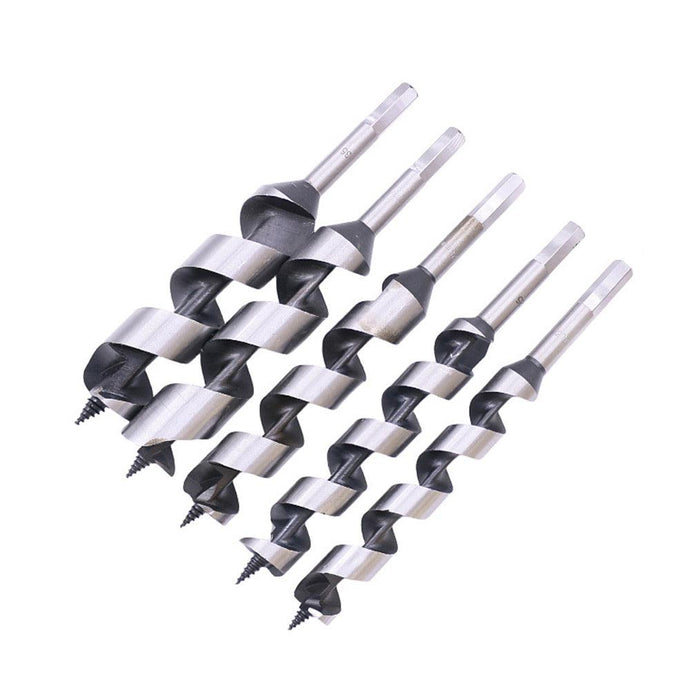In the vast world of drill bits, each type has its own unique strengths and applications. Among the most common bits for woodworking and home improvement projects is the spade bit. While it may not offer the precision of a Forstner bit or the all-purpose flexibility of a twist bit, the spade bit holds its own in a variety of situations where speed and efficiency are key. Understanding when to use a spade bit can help you make the most of its advantages and ensure your projects proceed smoothly.
The spade bit is easily recognizable by its flat, paddle-shaped design with two sharp cutting edges. This simple yet effective structure allows it to quickly remove material and drill large-diameter holes in wood and other softer materials. One of the most compelling reasons to choose a spade bit over other types is when you need to make a hole quickly. Spade bits are designed for speed, and their wide, flat design enables them to drill through wood faster than many other bits. For projects where time is of the essence, such as running electrical wiring through studs or drilling drainage holes in outdoor furniture, the spade bit is an ideal choice.
Another situation where spade bits excel is when you need to make large holes. Available in a variety of sizes, typically ranging from 1/4 inch to over 1-1/2 inches in diameter, spade bits are perfect for tasks that require substantial openings. For example, if you're installing a door lock, running pipes through wooden framing, or working on any project that involves creating larger-than-average holes, the spade bit is the tool for the job. Their wide, flat design cuts away more material with each rotation, making them far more efficient at drilling larger holes than a twist bit or brad point bit.
Spade bits are also a popular choice for rough, construction-grade work where a perfectly clean hole isn't necessary. When precision and finish aren't the primary concerns, the spade bit's speed and efficiency are unrivaled. If you're framing a house or working on a deck, and need to quickly bore through studs, beams, or posts, the spade bit is your best friend. Since its primary function is material removal over finesse, it may leave rougher edges around the hole than a Forstner or auger bit would, but for many construction tasks, this isn't a dealbreaker. When the holes are hidden behind walls or under flooring, a spade bit provides all the speed and utility you need without the added time and effort required to create perfectly smooth edges.
There are also practical considerations that make the spade bit a go-to tool for DIYers and professionals alike. One such factor is cost. Spade bits are generally inexpensive compared to other specialized bits like Forstners or hole saws. This makes them an excellent choice for projects where you may need to drill many holes of various sizes without worrying about wearing out an expensive bit. Moreover, because of their simple design, spade bits are relatively easy to sharpen, extending their lifespan and making them a cost-effective solution for long-term use.
Another important benefit of the spade bit is its versatility. While it's most commonly associated with woodworking, it can also be used to drill into other materials, such as plastic or composite materials. This makes it a valuable tool for tasks like creating access holes in plastic sheeting, running wiring through drywall, or working on projects that involve a mix of materials. However, it's important to note that spade bits are best suited for softer materials. Attempting to use one on metal or particularly hard surfaces will not only damage the bit but also reduce the quality of the hole you're trying to make.
Spade bits also have the ability to create angled holes, which is a major advantage in many practical situations. If you're running pipes or wiring through tight spaces, the flexibility to drill at an angle can make a big difference. For instance, when working in corners or areas with limited space, a spade bit's design allows you to start drilling at an angle, guiding the hole in the desired direction without the bit slipping or skidding across the surface. This makes the spade bit ideal for projects in cramped environments, such as under-floor plumbing or attic wiring, where awkward drilling angles are often required.
One limitation of spade bits is that they tend to leave behind rougher exit holes than some other types of drill bits. As they punch through the material, the opposite side of the hole may have splinters or tear-out. For projects where both sides of the hole will be visible, this can be a drawback. However, this issue can be minimized by placing a backing board behind the material being drilled, or by starting the hole from both sides of the material to avoid blowout.
In summary, a spade bit is an essential tool for anyone who needs to drill large, fast, and efficient holes, particularly in woodworking and other softer materials. It's an excellent choice for rough construction tasks, framing, electrical wiring, plumbing, and DIY projects where speed and functionality are more important than perfect aesthetics. Its affordability, versatility, and ability to handle large diameter holes with ease make it a must-have in any toolbox. Whether you're a professional contractor or a weekend warrior, knowing when to use a spade bit can significantly improve the efficiency and quality of your work.
